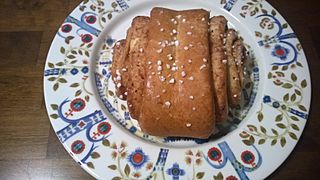Cinnamon roll facts for kids

A Swedish kanelbulle with pearl sugar
|
|
| Alternative names | Cinnamon bun, cinnamon swirl, cinnamon Danish, cinnamon snail |
|---|---|
| Type | Sweet roll |
| Place of origin | Sweden and Denmark |
| Region or state | Northern Europe |
| Main ingredients | Flour, cinnamon, sugar, and butter |
A cinnamon roll is a yummy sweet pastry. It's popular in many parts of the world, especially in countries like Sweden and Denmark in Northern Europe, and also in North America. People in different countries have their own names for it. For example, in Sweden, it's called kanelbulle, and in Finland, it's known as korvapuusti.
Contents
What is a Cinnamon Roll?
A cinnamon roll is made from a special kind of dough that rises with yeast. First, the dough is rolled out flat. Then, a mix of cinnamon and sugar is sprinkled over it, often on top of a thin layer of butter. Sometimes, other things like raisins are added too.
After that, the dough is rolled up tightly, like a spiral. This long roll is then cut into smaller pieces. These pieces are baked in an oven, or sometimes even deep-fried. The main ingredients are flour, cinnamon, sugar, and butter. These ingredients give the cinnamon roll its strong, sweet taste.
Where Did Cinnamon Rolls Come From?
The spice cinnamon originally came from Sri Lanka. Roman traders brought it to Europe a long, long time ago.
Much later, people in Sweden started using cinnamon in their pastries. This is how the kanelbulle (which means 'cinnamon bun') was created. In Sweden, people even celebrate Cinnamon Roll Day (Kanelbullens dag) every year on October 4th. Swedish cinnamon rolls often have cardamom spice in their dough, which gives them a special flavor.
The size of cinnamon rolls can be different depending on where you are. Many places sell smaller ones, about 5 centimeters (2 inches) wide. But you can also find much bigger ones! In Finland, for example, the korvapuusti can be up to 20 centimeters (8 inches) wide and weigh up to 200 grams (7 ounces).
There's a place in Gothenburg, Sweden, called Haga that is famous for its super-sized cinnamon rolls. These are called hagabullar, or 'Queen of the kitchen'. They can be 30 centimeters (12 inches) or more across! Even though they are huge, people usually order one for themselves. In Sweden, cinnamon rolls are often topped with pearl sugar, not the sweet icing you might see in North America.
Cinnamon Rolls Around the World
Different countries have their own versions of the cinnamon roll:
- The Swedish Butterkaka and Finnish bostonkakku (meaning "Boston cake") are like a cake made from cinnamon rolls. Instead of baking them separately, they are baked together in a round pan, so they stick to each other.
- In Germany, especially around Hamburg, there's a pastry called Franzbrötchen. It's a cinnamon pastry that was inspired by the French croissant, but it has cinnamon.
- The British have their own version called the Chelsea bun. It was invented in the 18th century and you can find it in cafes and bakeries all over the UK.
- In North America, cinnamon rolls often have a sweet icing on top, usually made with powdered sugar. Sometimes, they are even fried and covered in a glaze, like a type of donut. There are also some interesting local traditions. For example, in the Midwest, especially in Kansas, people sometimes eat cinnamon rolls with chili!
- In Canada, they are usually called cinnamon buns. They often have a natural glaze from baking and usually don't have icing or raisins. Some Canadian cinnamon buns have so much cinnamon that they taste quite spicy!
Cinnamon Roll Traditions
In Sweden and Finland, cinnamon rolls are a big part of a coffee break called fika. This is a special time to get together with friends and enjoy coffee and a treat. As mentioned before, October 4th is National Cinnamon Bun Day in both Sweden and Finland.
In North America, cinnamon rolls are often eaten for breakfast or as a dessert. If you have one for breakfast in the U.S., it might be served with a creamy cream cheese frosting.
Gallery
Images for kids
See also
 In Spanish: Rollo de canela para niños
In Spanish: Rollo de canela para niños







